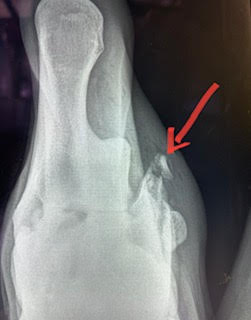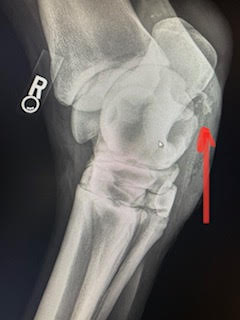Story of the small wound with a big impact.
We all know that horses like to get themselves in to trouble. And sometimes that trouble turns into a veterinary visit.
 Jack was found at pasture unwilling to bear weight on his right hind leg. The owner’s thought he might’ve gotten kicked by one of the other horses. There was a small wound the size of a dime on the inside of his right hock with some fluid draining from it. Jack was rushed into Roaring Fork Equine Medical Center for further evaluation. Sure enough when Jack arrived, he hardly wanted to put any weight on his right hind leg. The wound was noted to have a lot of clear liquid draining from it with every step. Due to Jack’s severe lameness and the area of the wound, we were concerned that the wound might’ve gone into Jack’s tibiotarsal joint (biggest joint in the hock) and even worse, Jack might’ve broken a bone. Radiographs (also known as x-rays) of the hock showed a small fragment coming off one of the hock bones. So it seemed that whatever caused the wound, also caused a small break in the bone. Thankfully, the bone break was very small and didn’t involve one of the big bones of the leg. But that’s not all.
Jack was found at pasture unwilling to bear weight on his right hind leg. The owner’s thought he might’ve gotten kicked by one of the other horses. There was a small wound the size of a dime on the inside of his right hock with some fluid draining from it. Jack was rushed into Roaring Fork Equine Medical Center for further evaluation. Sure enough when Jack arrived, he hardly wanted to put any weight on his right hind leg. The wound was noted to have a lot of clear liquid draining from it with every step. Due to Jack’s severe lameness and the area of the wound, we were concerned that the wound might’ve gone into Jack’s tibiotarsal joint (biggest joint in the hock) and even worse, Jack might’ve broken a bone. Radiographs (also known as x-rays) of the hock showed a small fragment coming off one of the hock bones. So it seemed that whatever caused the wound, also caused a small break in the bone. Thankfully, the bone break was very small and didn’t involve one of the big bones of the leg. But that’s not all.
In order to tell if the wound was in the hock joint, we performed standing arthrocentesis (tapping of the joint). We sterilely placed a needle on the other side of the joint and began filling the joint with sterile saline. In only a short matter of time, we saw the saline coming out of the wound. This told us that the wound entered the hock joint. So poor Jack had a small broken bone in his hock and a wound into the joint. As most people know, infected joints and broken bones are really bad in horses and can sometimes be life-threatening. Thankfully for Jack, we treated aggressively with antibiotics and anti-inflammatories and saw a gradual improvement. Jack was sent home one week later and was walking comfortably on his right hind limb.


The owner’s diligently kept Jack in a stall for weeks and when we rechecked Jack in one month he was walking sound with no evidence of joint enlargement. One month after that, Jack was trotting sound! We were all happy to see Jack’s full recovery. This story shows the importance of bringing a horse with a possible infected/wounded joint into the clinic as soon as possible. Although we can evaluate infected or wounded joints in the field, our clinic is the best place to perform evaluation. It allows us a clean and controlled environment so we can come to a quick diagnosis and initiate treatment immediately. If Jack wasn’t brought in to the clinic immediately, he might’ve developed an infection in his joint that would have required more extensive treatment and possible permanent joint damage.
